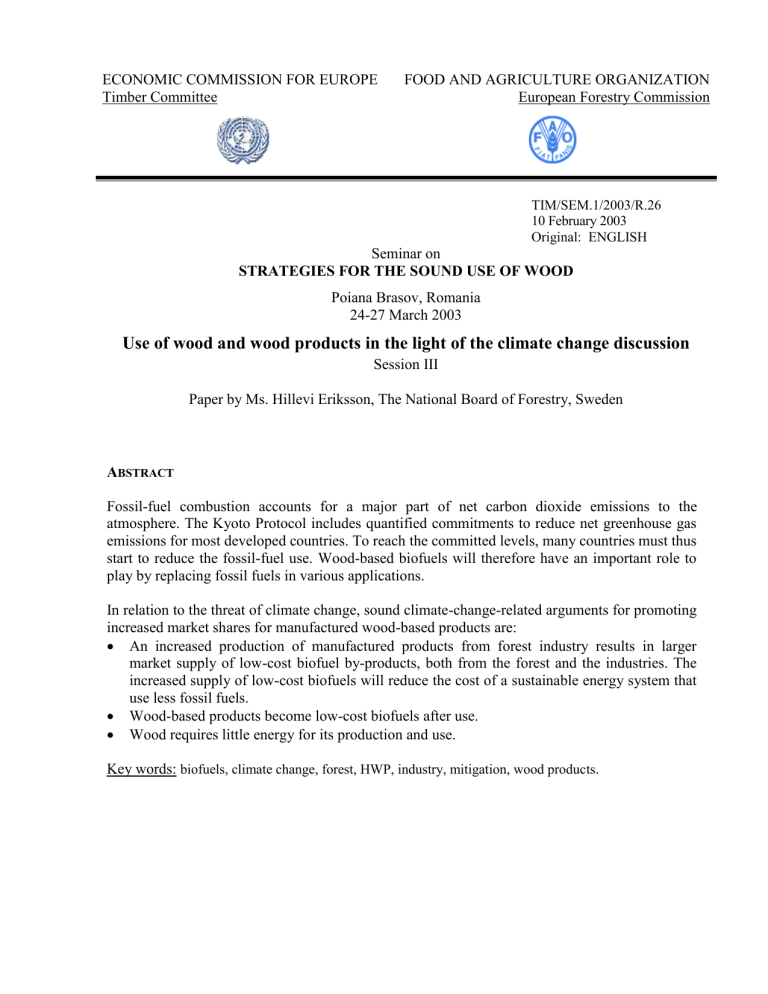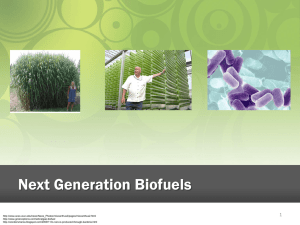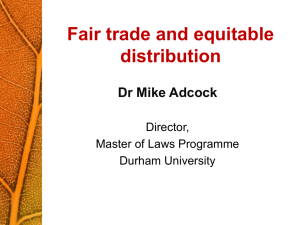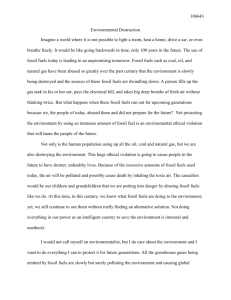Discussion on Potential impact on GHG emissions from using wood

ECONOMIC COMMISSION FOR EUROPE
Timber Committee
FOOD AND AGRICULTURE ORGANIZATION
European Forestry Commission
TIM/SEM.1/2003/R.26
10 February 2003
Original: ENGLISH
Seminar on
STRATEGIES FOR THE SOUND USE OF WOOD
Poiana Brasov, Romania
24-27 March 2003
Use of wood and wood products in the light of the climate change discussion
Session III
Paper by Ms. Hillevi Eriksson, The National Board of Forestry, Sweden
A
BSTRACT
Fossil-fuel combustion accounts for a major part of net carbon dioxide emissions to the atmosphere. The Kyoto Protocol includes quantified commitments to reduce net greenhouse gas emissions for most developed countries. To reach the committed levels, many countries must thus start to reduce the fossil-fuel use. Wood-based biofuels will therefore have an important role to play by replacing fossil fuels in various applications.
In relation to the threat of climate change, sound climate-change-related arguments for promoting increased market shares for manufactured wood-based products are:
An increased production of manufactured products from forest industry results in larger market supply of low-cost biofuel by-products, both from the forest and the industries. The increased supply of low-cost biofuels will reduce the cost of a sustainable energy system that use less fossil fuels.
Wood-based products become low-cost biofuels after use.
Wood requires little energy for its production and use.
Key words: biofuels, climate change, forest, HWP, industry, mitigation, wood products .
TIM/SEM.1/2003/R.26 page 2
I
NTRODUCTION
During the 80’s, the awareness increased among scientists about the climate implications of increasing greenhouse gas (GHG) concentrations in the atmosphere. The United Nations'
Intergovernmental Panel of Climate Change (IPCC) concluded that the increase in greenhouse gas concentrations must be strongly limited compared to the business-as-usual scenario over the coming decades. Otherwise, the climate changes are expected to threaten human food maintenance in several regions of the world as well as the occurrence of many natural ecosystems
(IPCC 2001a). Intergovernmental negotiations resulted in a frame convention about climate change (UNFCCC) that was accepted in Rio de Janeiro in 1992. The objective with the convention is to stabilise GHG emissions at levels that do not cause climate changes with adverse effects on natural ecosystems and humankind.
Fossil-fuel combustion accounts for a major part of net carbon dioxide emissions. The UNFCCC states that the largest share of historical and currant emissions has originated in developed countries and that per-capita emissions in developing countries are still relatively low (Anon.,
1998a).
Over the last decade, the scientific community has been able to confirm that the average of the global temperature has increased in a pace that correspond to climate modelling projections, and that hardly can be explained by natural variation (IPCC 2001b).
After the ratification of the UNFCCC started the negotiations on the Kyoto Protocol. It was largely agreed in 2001, and ratified by most countries with written commitments during 2002. At present (Feb 2003), we are awaiting the ratification by Russia that would make the Protocol legally binding. In the protocol, we find quantified commitments by industrialised countries to reduce net greenhouse gas emissions. To reach the committed levels, most countries must start to reduce their use of fossil fuels. However, the sum of commitments within the protocol is far from enough to fulfil the objective of the UNFCCC (compare Anon. 1998 b and IPCC 2001c).
The Kyoto protocol also includes options to receive credits for increasing carbon (C) pools in wood and in forest soils. Maximum credit values are set for each country concerned. The possibility to include changes in pools of harvested wood products in a credit system has been discussed. It was agreed not to include any such option, at least not for the first commitment period (i.e. 2008-2012).
TIM/SEM.1/2003/R.26 page 3
D ISCUSSION ON P OTENTIAL IMPACT ON GHG EMISSIONS FROM USING WOOD BASED PRODUCTS
Problems of sink options
The use of wood-based products (excluding biofuels) could affect the global C budget in several ways. Often considered is apparently the possibility to increase the pool of harvested wood products in the society, and thereby binding C from the atmosphere in the building and product pool. This would create a temporary so-called sink of C. Another suggested option is that an increased demand for sawmill products would result a higher demand for large trees. This would then result in longer rotation periods and thus increased C stocks of the forests. However, as the space for further storage is limited, both of these options only result in temporary benefit for the
C balance of the world. Moreover, major adverse effects could follow if a potential increase in these C pools is valued so highly that an economic incentive (e.g. a credit system) is invented to increase the stocks of various organic C pools:
I) The C stock of a biomass or soil pool is a function of the applied land use. If an economic incentive is needed to increase a certain C stock in such a pool, further economic incentives will be needed to maintain the new stock, also when the new steady-state stock level is reached. In case maintenance ceases, the extra C fixed will return to atmosphere.
Thus, although increasing the C stock could be cheap compared to decreasing fossil-fuel use in the near-term perspective, the maintenance of the increased stock could continue to increase option costs (per g C) for all future.
II) In certain cases, a stock increase may lower the production potential of low-cost biofuels.
In such a case, a focus on the stock could result in a land use that is suboptimal in a longer time perspective
III) If the global potential for increasing the stock is rather limited, such as for the wood product pool, a credit system for increasing the stock in a coming protocol could create high administrative costs for little mitigation value.
To replace fossil fuels is viable in the long-term perspective
Fossil-fuel combustion accounts for a major part of net carbon dioxide emissions. To reach the committed levels, most countries must start to reduce their use of fossil fuels. In many countries, wood-based biofuels may therefore have an important role to play by replacing fossil fuels in various applications (e.g. Richardson et al . 2002; Gustavsson et al . 1995). A carbon dioxide tax on fossil fuels for heat production and transporting was introduced in Sweden in 1991.
Subsequently, biofuels in form of by-products from clear-felling and the forest industry have replaced fossil fuels to an extent that roughly correspond to between 5 and 10 % of the total
Swedish energy consumption.
Fossil-based production of heat for a single-family wooden house in Sweden emits roughly the same amount of C, annually, that is stored in the house, including furniture and paper products (c.
2-3 ton C). This fact illustrates that options affecting the choice of energy source for heat and
TIM/SEM.1/2003/R.26 page 4 electricity production are potentially far more important than any option that aim to increase the
C pool in houses.
Consequently, all options are important that contribute to the development of sustainable nonfossil energy systems, and thus to a long-term viable solution of the climate change problem. In this respect, there are three major contributions that may follow from increasing the consumption of products from the forest industry (i.e. products other than primary biofuels):
A) The high production of by-products that can be used as biofuels that normally occur in the traditional forestry and forest industries (harvest residues, bark, sawdust, lignin, residue wood, etc). These biofuels are generally cheap, and increased production contribute to lower the cost for replacing fossil fuels.
B) Most wood-based products may become biofuels after use (and reuse). In case they can be used, these biofuels are even cheaper since it is normally a cost connected to waste depositing.
C) Wood-based products may replace products with higher life-cycle energy requirements.
C
ONCLUSIONS
In relation to the climate change problem, sound arguments for promoting increased market shares for manufactured wood-based products are:
1.
An increased production of manufactured products from forest industry results in larger market supply of low-cost biofuel by-products, both from the forest and the industries. The increased supply of low-cost biofuels will reduce the cost of a sustainable energy system that use less fossil fuels.
2.
Wood-based products become low-cost biofuels after use.
3.
Wood requires little energy for its production and use.
TIM/SEM.1/2003/R.26 page 5
R EFERENCES
Anon. 1998a. Climate Change Convention. Climate Change Secretariat (secretariat@unfccc.de).
Anon. 1998b. The Kyoto Protocol to the Convention on Climate Change. Climate Change
Secretariat (secretariat@unfccc.de).
IPCC. 2001a. IPCC Third Assessment Report: Climate Change 2001. Impact, Adaptation and
Vulnerability. Contribution of Working Group II to the Third Assessment Report of IPCC.
Cambridge Univ. Press, England. ISBN 0521807689.
IPCC. 2001b. IPCC Third Assessment Report: Climate Change 2001. The Scientific Basis.
Contribution of Working Group I to the Third Assessment Report of IPCC. Cambridge Univ.
Press, England. ISBN: 0521014956
IPCC. 2001c. IPCC Third Assessment Report: Climate Change 2001. Mitigation. Contribution of
Working Group III to the Third Assessment Report of IPCC. Cambridge Univ. Press,
England.ISBN: 0521807697
Gustavsson L., Boerjesson P., Johansson B. & Svenningsson P. 1995. Energy Vol 20, 11:1097-
1113.
Richardson J., Bjoerheden R., Hakkila P. Lowe A.T. & Smith C.T. Bioenergy from Sustainable
Forestry. Kluwer Academic Publishers. ISBN 1-4020-0676-4
C ONTACT ON A UTHOR ( S ):
Ms. Hillevi M Eriksson
The National Board of Forestry of Sweden
Department of Silviculture
551 83 Jonkoping, Sweden
Tel: +46 - 36 - 15 55 60
Fax: +46 - 36 - 16 61 70








